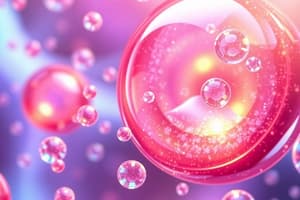Podcast
Questions and Answers
Which type of colloid forms a continuous network of both dispersed solid and liquid phases?
Which type of colloid forms a continuous network of both dispersed solid and liquid phases?
- Solution
- Emulsion
- Gel (correct)
- Suspension
What is the primary difference between a gel and an emulsion colloid?
What is the primary difference between a gel and an emulsion colloid?
- Gels have dispersed solid and liquid phases forming a continuous network, while emulsions are two immiscible liquids mixed together. (correct)
- Gels have particles isolated within the liquid medium, while emulsions have large surface areas.
- Gels consist of gas bubbles in liquid, while emulsions consist of liquid droplets in another liquid.
- Gels have large particles between 1 and 1000 nanometers in diameter, while emulsions have smaller particles.
What is a common example of a suspension colloid?
What is a common example of a suspension colloid?
- Salad dressing
- Milk
- Mayonnaise
- Blood (correct)
Why do colloidal particles exhibit unique properties compared to traditional solid materials?
Why do colloidal particles exhibit unique properties compared to traditional solid materials?
What distinguishes emulsion colloids from suspension colloids?
What distinguishes emulsion colloids from suspension colloids?
Which type of colloid has high surface area relative to traditional solid materials?
Which type of colloid has high surface area relative to traditional solid materials?
Which of the following phenomena is directly influenced by the high surface area of colloidal particles?
Which of the following phenomena is directly influenced by the high surface area of colloidal particles?
How can the behavior and stability of colloids be tuned?
How can the behavior and stability of colloids be tuned?
Which method is used to create stable emulsions?
Which method is used to create stable emulsions?
What is the primary role of adsorption in the stabilization of colloids?
What is the primary role of adsorption in the stabilization of colloids?
Which of the following is an example of a colloidal system in food science?
Which of the following is an example of a colloidal system in food science?
Which of the following applications of colloids is related to medical sciences?
Which of the following applications of colloids is related to medical sciences?
Flashcards are hidden until you start studying
Study Notes
Colloid Chemistry: Understanding Particles, Their Behavior, and Applications
Colloid chemistry is a branch of chemistry concerned with colloidal systems. These systems consist of particles suspended in another medium, such as gas bubbles in water or oil droplets in vinegar. This field of study explores the behavior and properties of these suspensions, which can have significant applications in various industries.
Colloidal Systems and Their Components
Types of Colloids
There are three primary types of colloids based on the nature of the dispersed phase and the dispersion medium:
-
Gel: In this type of colloid, both the dispersed solid and liquid phases form a continuous network. Examples of gels include milk, mayonnaise, and some jellies.
-
Suspension: Here, dispersed solid particles remain isolated within the liquid medium. Blood and paint are common examples of suspension colloids.
-
Emulsion: In emulsions, two immiscible liquids are mixed together with the help of an emulsifying agent. Milk, salad dressing, and mayonnaise are emulsion colloids where oil and water are the immiscible components.
Properties of Colloids
Colloidal particles exhibit unique properties due to their size, typically between 1 and 1000 nanometers in diameter. Some key characteristics include:
-
High surface area: Due to their small particle sizes, colloids have large surfaces areas relative to traditional solid materials.
-
Interfacial phenomena: The high surface area of colloidal particles leads to increased interfacial phenomena, such as adsorption and catalysis.
-
Tunable properties: By altering factors like pH, temperature, and concentration, the behavior and stability of colloids can be tuned.
Preparation and Stabilization of Colloids
The process of preparing stable colloidal systems is crucial for achieving desired properties and applications. Common methods used to obtain stable colloids include:
Emulsification
To create stable emulsions, emulsifiers are often added to reduce interface tension between the immiscible liquids and facilitate particle stabilization.
Coacervation
This method involves the precipitation of polymers from solutions, leading to the formation of coats around the dispersed particles, thus preventing aggregation.
Adsorption
Adsorbed layers of molecules onto the surface of colloidal particles can offer electrostatic or steric stabilization, preventing particle interactions and promoting stability.
Applications of Colloids
Colloid chemistry has numerous practical applications in various fields, including:
-
Medical sciences: Biological fluids like blood and serum are colloidal systems. Enzyme-linked immunosorbent assays (ELISA) utilize colloidal gold particles to detect specific antigens.
-
Food science: Gelatin, starch, egg white, and yogurt are all colloidal systems that play essential roles in food texture and appearance.
-
Pharmaceuticals: Many medications rely on colloidal delivery systems, such as liposomes, microspheres, and nanosensors, for improved drug targeting and efficacy.
In conclusion, colloid chemistry is a fascinating field that offers insights into the complex world of particles and their behaviors. Understanding the principles behind colloidal systems, their preparation, and their utilization in diverse domains can lead to innovative advancements across multiple industries.
Studying That Suits You
Use AI to generate personalized quizzes and flashcards to suit your learning preferences.





